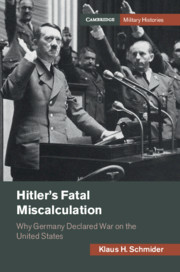Book contents
- Hitler’s Fatal Miscalculation
- Cambridge Military Histories
- Hitler’s Fatal Miscalculation
- Copyright page
- Epigraph
- Contents
- Figures
- Maps
- Preface
- Acknowledgements
- Abbreviations and German and Russian Terms
- Introduction
- 1 Hitler’s Pre-War Assessment of the United States and Japan
- 2 Hitler’s Physical Health in Autumn 1941
- 3 ‘All Measures Short of War’: the German Assessment of American Strategy, 1940–1941
- 4 Forging an Unlikely Alliance: Germany and Japan, 1933–1941
- 5 Facing the Same Dilemma: the US and German Quest for Rubber
- 6 The Crisis of the German War Economy, 1940–1941
- 7 The End of Blitzkrieg? Barbarossa and the Impact of Lend-Lease
- 8 The Battle of the Atlantic
- 9 The Luftwaffe on the Eve of Global War
- 10 The Holocaust
- Conclusion
- Bibliography
- Index
6 - The Crisis of the German War Economy, 1940–1941
Published online by Cambridge University Press: 08 January 2021
- Hitler’s Fatal Miscalculation
- Cambridge Military Histories
- Hitler’s Fatal Miscalculation
- Copyright page
- Epigraph
- Contents
- Figures
- Maps
- Preface
- Acknowledgements
- Abbreviations and German and Russian Terms
- Introduction
- 1 Hitler’s Pre-War Assessment of the United States and Japan
- 2 Hitler’s Physical Health in Autumn 1941
- 3 ‘All Measures Short of War’: the German Assessment of American Strategy, 1940–1941
- 4 Forging an Unlikely Alliance: Germany and Japan, 1933–1941
- 5 Facing the Same Dilemma: the US and German Quest for Rubber
- 6 The Crisis of the German War Economy, 1940–1941
- 7 The End of Blitzkrieg? Barbarossa and the Impact of Lend-Lease
- 8 The Battle of the Atlantic
- 9 The Luftwaffe on the Eve of Global War
- 10 The Holocaust
- Conclusion
- Bibliography
- Index
Summary
The output of large parts of the German war economy was, if not quite in crisis, then certainly lagging by the autumn of 1941. It had reached a point where it was struggling to meet the current demands of the field army in Russia fighting in Russia, let alone those raised by the planned large-scale expansion of the Luftwaffe. Against such a backdrop, the idea of escalating the war by dragging another great power into it gives legitimacy to the view put forward by some historians that Hitler was seeking his self-immolation.
A close examination of the sources, however, indicates that Hitler had reached the conclusion that far from having hit a glass ceiling the German economy still possessed considerable slack which could be mobilised by rationalising designs and optimising the allocation of labour and raw materials. As a precedent, he could point to the months of January-April 1940 where a last-minute spurt in productivity had provided much of the ammunition and tanks needed for the campaign in the West. It goes without saying that this forecast mistakenly assumed a marked decrease in the intensity of the fighting in Russia on account of the fall of the Donbass industrial area.
- Type
- Chapter
- Information
- Hitler's Fatal MiscalculationWhy Germany Declared War on the United States, pp. 298 - 320Publisher: Cambridge University PressPrint publication year: 2021

